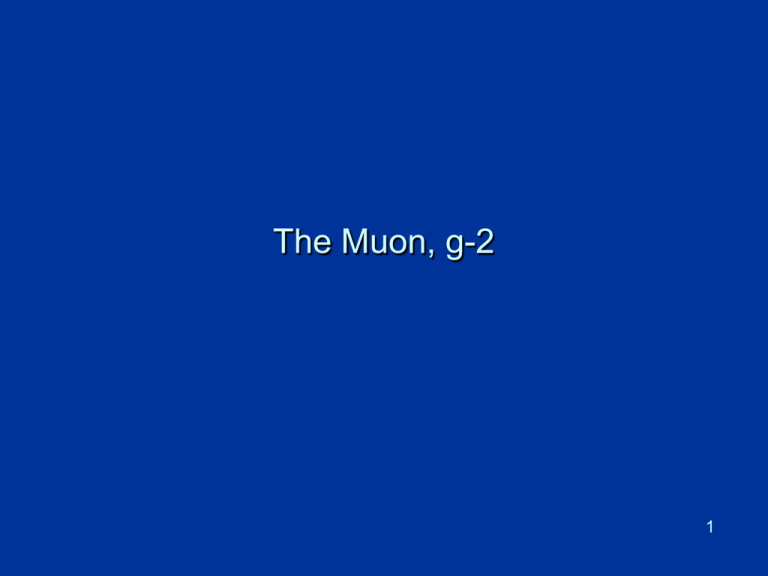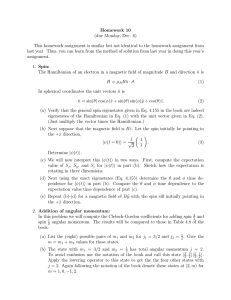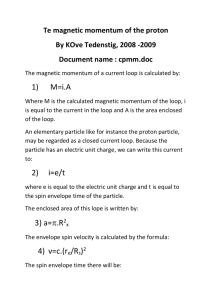The Muon, g-2 1
advertisement

The Muon, g-2 1 Atoms in magnetic field orbiting electron behaves like current loop magnetic moment μ = current x area interaction energy = μ·B (both vectors!) = μ·B loop current = -ev/(2πr) angular momentum L = mvr magnetic moment = - μB L/ħ μB = e ħ/2me = “Bohr magneton” interaction energy n = m μB Bz A (m = z comp of L) L (m = z I r e 2 Gyromagnetic ratio orbiting charged particle behaves like current loop magnetic moment μ = current x area loop current = qv/(2πr) angular momentum L = mvr qv q q magnetic moment IA 2 r r 2 2m mvr 2m L GL Same formula is obtained for rotating body (can be thought of as consisting of many small particles orbiting around axis) Def: gyromagnetic ratio L G= ratio between magnetic dipole n A moment and angular momentum I r For classical particle q L 2m q 3 Gyromagnetic ratio for spin For microscopic particles, there may be additional factor g g G L For classical body and orbital ang. mom., “gfactor” = 1 For isolated electron g=2 according to Dirac equation g e G S , S= spin .....) QED predicts that g2 g e 2(1 a) 2(1 2 a=(g-2)/2 (“anomaly”) for the electron has been calculated and measured to very high precision 4 (12 decimal places) Summary of S the moment consists of 2 parts Dirac + Pauli moment the anomaly or SM predicts a 5 The Muon First observed in cosmic rays in 1933 Paul Kunze, Z. Phys. 83, 1 (1933) “a particle of uncertain nature” 6 Identified in 1936 Study of cosmic rays by Seth Neddermeyer and Carl Anderson 7 B. L. Roberts, Fermilab , 3 September 2008 - p. 7/68 Confirmed by: Street & Stevenson, Nishina, Tekeuchi & Ichimiya 8 It took 10 years to conclude that the muon interacted too weakly with matter to be the “Yukawa” particle which was postulated to carry the nuclear force The Standard Model (Our Periodic Table) Leptons ne Interact weakly through the t nt Z0 g Electroweak gauge bosons Quarks n e W± u c t d s b Interact strongly through the gluons g 9 Spin, helicity As all matter particles, leptons are spin ½ particles “helicity” =projection of spin on momentum direction (component of spin in mom dir.) Left and right-handedness: “left-handed” fermion: spin is in the opposite direction to their momentum “right-handed” fermion: spin is in the same direction as their momentum According to SM: only left-handed fermions and right-handed antifermions participate in weak interactions “right-handed e+, +, t+ and “left-handed e-, -, t- feel weak int. (corresponding statements for neutrinos and quarks) 10 Death of the Muon Decay is self analyzing The highest energy e± from ± decay carry information on the spin direction. 11 Theory of Magnetic and Electric Dipole Moments Dirac equation Relativistic generalization of Schrödinger equation Predicts spin of electron Predicts antiparticles (positron) Predicts ge = 2 Proc. R. Soc. (London) A117, 610 (1928) 12 Quantum electrodynamics: radiative corrections change g from its Dirac value of 2. corrections symbolically expressed as “Feynman diagrams” Dirac Stern-Gerlach Schwinger Kusch-Foley perturbation expansion: 13 g-2 for muons Calculation somewhat more complicated: Muon mass 200 times electron mass Some corrections depend on mass rations – bigger contributions for muon 14 The SM Value for electron, muon and tau anomalies e*, e, e, e, e, e, e, e, e, e, e, e vs. : relative contribution of heavier things 15 Theory calculation [47] DHMZ, Eur.Phys.J.C72:1874 (2012) [48] HLMNT, J.Phys.G38,085003 (2011) a= (286 80) X 10-11 [47] a= (260 78) X 10-11 [48] • Dominating theoretical uncertainties are hadronic components • Most from low energy non-perturbative QCD regime • The hadronic vacuum polarization (HVP) is related to the cross section for hadron production e+e- → hadrons • The hadronic light by light (HLbL) is model specific (cannot be determined from data directly), much less known (25% error) • Lattice QCD is starting to get involved, could be a big help 16 Comparison (3 – 3.6) difference depending on HVP LO contribution • If the discrepancy between the theory and the experimental result sustains, it can point to new physics • More importantly, a tightly constraints new physics models and has 17 significant implications to interpret any new phenomena Spin Motion in a Magnetic Field charged (q) particle moving in a magnetic field: momentum turns with cyclotron frequency C, spin turns with S C qB , S g qB (1 g ) qB gm 2m gm Spin turns relative to momentum with a g 2 qB qB a C S a m 2 m Measure the frequency difference between the spin and momentum precession 18 How to measure? • Put (polarized) muons in a magnetic field and measure precession freq • Get muon spin direction from decayed electrons - • a ~ difference between precession frequency and cyclotron frequency eB a C S a m g=2 eB eB C , S g m 2m g>2 19 1 9 A slight complication… The magic muon momentum • Muons make horizontal circular movement under influence of magnetic field B, what about vertical movement? • Need to use electrostatic quadrupoles to confine muons vertically, this brings additional complication e 1 [a B (a 2 )( E )] m g 1 • How to measure E? • No need! choose g = 29.3, then coefficient vanishes! • g = 29.3 means p= 3.09 GeV (magic momentum) 20 2 0 The magic muon momentum Muons make horizontal circular movement under influence of magnetic field B, what about vertical movement? Need to use electrostatic quadrupoles to confine muons vertically, this brings additional complication e 1 [a B (a 2 )( E )] m g 1 21 Experimental Technique AGS experiment π Proton bunches from accelerator xc ≈ 77 mm ≈ 10 mrad B·dl ≈ 0.1 Tm Pions n Inflector B p=3.1GeV/c (1.45T) Target • Muon polarization • Muon storage ring • injection & kicking • focus with Electric Quadrupoles • 24 electron calorimeters Injection orbit Central orbit Storage ring Kicker Modules R Electric Quadrupoles B. L. Roberts, Fermilab , 3 September 2008 R 22 - p. 22/68 xc muon (g-2) storage ring at BNL Muon lifetime t = 64.4 s (g-2) period ta = 4.37 s Cyclotron period tC = 149 ns B. L. Roberts, Fermilab , 3 September 2008 23 - p. 23/68 The experiment setup 24 To measure a, we used Pb-scintillating fiber calorimeters. 400 MHz digitizer gives t, E Count number of e- with Ee ≥ 1.8 GeV 25 BNLexpt 821: arrival-time spectrum of high-energy decay electrons N (t ) t N (0)e [1 A cos(at )] 9 4 10 e , Ee 1.8GeV 26 B. L. Roberts, Fermilab , 3 September 2008 - p. 26/68 Fermilab expt: Measuring a The integrated number of electrons (above Eth) modulated at a Angular distribution of decayed electrons correlated to muon spin 27 Five parameter fit to extract a Fermilab Muon Campus 28 Fermilab Muon Campus 29 The ring has moved… Disassembly The Big Move arrived at FNAL July 2013 30 Detector upgrade Two laser pulses at SiPM by 5ns Segmented, fast response, crystal calorimeter Lead-fluoride Cherenkov crystal (PbF2) can reduce pileup Silicon photomultiplier (SiPM) directly on back of PbF2 Not disturb magnetic field, avoid long lightguides 31 Summary The measurement of e ± and ± magnetic dipole moments has been an important benchmark for the development of QED and the standard model of particle physics. Presently, difference between measured a and the standard-model prediction (3.6 ) theory situation is evolving a has been particularly valuable in restricting physics beyond the standard model. will continue to be important in guiding the interpretation of the LHC data. 32 Summary – g-2 at Fermilab Flagship project within Fermilab muon campus Received Mission Need approval g-2 is extremely sensitive to new physics and high order calculations, correction Aiming to reduce experimental uncertainty by a factor of 4 Theoretical uncertainty also expected to reduce by a factor of 2 Could achieve 5.6 deviation with the same central value Great discovery potential and bright future in line with Fermilab muon / Project-X programs 33 References, acknowledgments Used slides from presentations by experts: Lee Roberts http://g2pc1.bu.edu/~roberts/ Liang Li talk at SPSC2013 https://indico.cern.ch/event/234546/session/9/contribution/20/attachments/392218/545413/Muon _g-2_Experiment_at_Fermilab_SPCS2013.pdf Hoecker&Marciano: g-2 summary at PDG http://pdg.lbl.gov/2013/reviews/rpp2013-rev-g-2-muon-anom-mag-moment.pdf 34



